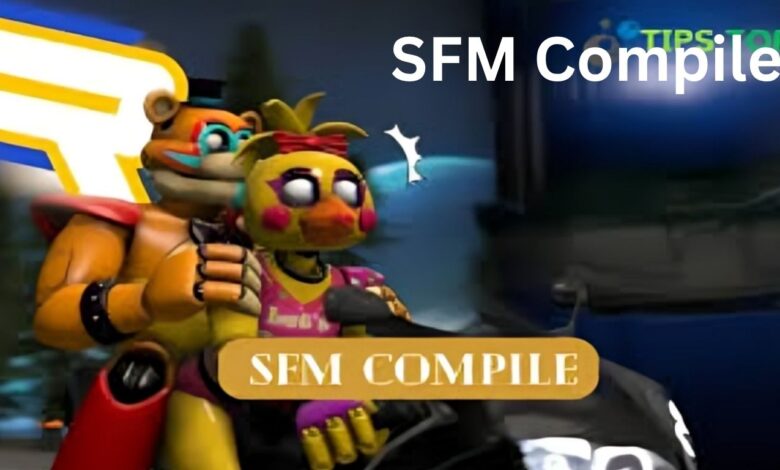SFM Compile The Ultimate Guide to Understanding and Using Source Filmmaker Compiling Tools

If you’re part of the animation, gaming, or 3D modeling community, you’ve probably heard of Source Filmmaker (SFM). Developed by Valve Corporation, SFM is a powerful video production tool that allows creators to make animated films using assets from the Source engine. One essential aspect of mastering this tool is learning how to sfm compile—the process of building and rendering your animations into a final video format.
In this detailed guide, we’ll explore everything about sfm compile, from what it is and how it works to advanced tips for optimizing your projects. Whether you’re a beginner or a professional animator, understanding compiling in SFM is crucial for achieving high-quality results.
What Is SFM Compile?
The term “sfm compile” refers to the process of taking your Source Filmmaker project and converting it into a final video output. This involves rendering your animation frames, compiling the models, textures, sounds, and effects into a cohesive video file.
In simple words, sfm compile is the final stage of your animation workflow where all the creative elements come together to produce the finished film or clip.
Why SFM Compile Is Important
Compiling your SFM project is not just about exporting your video. It’s about ensuring:
- Smooth playback of animations
- Optimized file size for sharing or uploading
- High-quality visuals with proper lighting and shadows
- Accurate rendering of models, props, and particle effects
A proper sfm compile ensures that what you see in the preview window is exactly what your audience will see in the final product.
How to Compile in Source Filmmaker (Step-by-Step)
Let’s break down the process of sfm compile into simple, actionable steps.
Step 1: Finalize Your Project
Before you compile, make sure your timeline, camera angles, and animation are finalized. Go through your scene to ensure there are no missing textures, lighting errors, or misplaced props.
Step 2: Adjust Render Settings
Go to the Render Settings window in SFM. Here you can:
- Choose your resolution (e.g., 1080p, 4K)
- Adjust sampling quality for better anti-aliasing
- Set your frame rate (FPS)—typically 24 or 30 for cinematic output
Step 3: Choose the Output Format
SFM allows you to export either as .AVI or .TGA sequence. The TGA image sequence is preferred by professionals because it provides maximum image quality for post-production editing.
Step 4: Compile the Animation
In the File menu, click Export > Movie. Choose your directory and export options. SFM will begin the compiling process, rendering each frame of your animation.
Step 5: Post-Processing
Once your sfm compile is complete, you can use external video editors like Adobe Premiere Pro, DaVinci Resolve, or Vegas Pro for color correction, sound mixing, and adding final effects.
Common Issues During SFM Compile (and How to Fix Them)
Even experienced users encounter problems during the sfm compile process. Here are some of the most common issues and how to solve them.
1. Low-Quality Output
If your final video looks pixelated or blurry, check your render settings. Increase your sample rate, and make sure your motion blur and ambient occlusion settings are properly configured.
2. Missing Textures or Models
This usually happens when models are not properly loaded or are missing from your game directory. Rebuild your cache and make sure all assets are properly mounted before compiling.
3. Crashes During Compilation
SFM can crash if your system runs out of memory. Try reducing your resolution or splitting your animation into smaller segments before compiling.
4. Audio Sync Issues
When exporting as AVI, audio sometimes goes out of sync. Using image sequences (TGA/PNG) and syncing audio in post-production is a reliable workaround.
Optimizing Your SFM Compile for Best Performance
To get the most out of your sfm compile, optimization is key. Here’s how you can improve speed and quality simultaneously.
1. Use Render Queues
SFM allows you to render scenes overnight using render queues. This helps manage system resources efficiently.
2. Adjust Lighting Before Compiling
Proper lighting setup is essential. Previews may differ from the final output, so always test your lighting with sample renders before a full compile.
3. Enable Motion Blur and Depth of Field
These settings give your video a cinematic look but can slow down compile times. Use them carefully and only when necessary.
4. Use Powerful Hardware
A strong GPU and ample RAM will drastically reduce sfm compile times. SSDs also help with faster read/write operations.
Advanced Techniques in SFM Compile
If you’re ready to take your SFM projects to the next level, consider these advanced compiling techniques.
1. Using External Renderers
Some users export their animations frame-by-frame and use advanced renderers like Blender Cycles, Source 2, or After Effects for better lighting and visual fidelity.
2. Command-Line Compiling
SFM supports command-line arguments that allow for batch rendering and automation. This is ideal for large projects or studios handling multiple shots simultaneously.
3. Custom Codecs
By installing custom video codecs (like H.264 or DNxHD), you can achieve better compression without sacrificing quality. Always ensure codec compatibility with your editing software.
Tips for Faster and More Efficient SFM Compile
Use Scene Organization
Organize your timeline using bookmarks and folders. This makes it easier to manage shots and identify potential issues before compiling.
Render in Chunks
Instead of compiling an entire 10-minute film at once, render smaller sections and combine them later. This approach minimizes crash risks and saves time on re-renders.
Keep Backups
Always maintain backups of your project files. SFM can be unstable, and losing hours of animation work due to a crash can be devastating.
Disable Unused Elements
Turn off props, lights, or models not visible in your camera view. This reduces render load and speeds up compile times.
Comparing SFM Compile with Other Animation Tools
| Feature | Source Filmmaker (SFM) | Blender | Unreal Engine |
| Ease of Use | Moderate | Complex | Moderate |
| Compile Speed | Medium | Slow | Fast |
| Output Quality | High | Very High | Ultra High |
| Community Support | Strong | Huge | Strong |
| Best For | Game-based animations | 3D films | Real-time rendering |
While SFM is excellent for Source engine-based content, tools like Blender or Unreal Engine may offer more advanced rendering pipelines. However, SFM remains a fan favorite for Valve-related content due to its accessibility and integration with Steam Workshop assets.
SEO Benefits of Targeting “SFM Compile”
For bloggers, YouTubers, or tutorial creators, targeting the keyword sfm compile can significantly boost your visibility. It’s a niche yet popular term in the animation and modding communities. Including the keyword strategically (as done in this article) ensures:
- Higher ranking on Google for SFM-related tutorials
- Increased organic traffic from animation enthusiasts
- Authority building within the Source Filmmaker community
If you run a tech or creative media site, creating guides around sfm compile and related topics like “SFM rendering” or “Source Engine animation” can attract a loyal audience.
Troubleshooting Guide: When Your SFM Compile Fails
When a sfm compile fails, follow this checklist:
- Check your console logs for error messages.
- Update GPU drivers and ensure SFM is running in administrator mode.
- Verify the integrity of your Source Filmmaker files via Steam.
- Clear the render cache to avoid data corruption.
- Try rendering without audio, then sync sound in post-production.
If the issue persists, consult community forums like Steam Discussions or Reddit’s /r/SFM, where experienced animators often share troubleshooting tips.
Best Settings for Professional SFM Compiles
| Setting | Recommended Value |
| Resolution | 1920×1080 or 3840×2160 |
| Frame Rate | 30 FPS |
| Anti-Aliasing | 8x or higher |
| Shadow Quality | High |
| Motion Blur | Enabled (0.15–0.25) |
| Output Format | TGA Image Sequence |
| Lighting Samples | 64 or higher |
Following these settings ensures your sfm compile yields professional-grade visuals ready for YouTube, Vimeo, or film festivals.
The Future of SFM and Compiling Tools
Although Source Filmmaker has been around for years, Valve continues to improve the platform, especially with Source 2 Filmmaker (S2FM) in development. This next-generation version will offer:
- Faster compile times
- Better real-time rendering
- Support for modern GPUs and ray tracing
- Advanced animation layers and improved physics
The future of sfm compile looks bright, with more efficient tools and community support ensuring that filmmakers and content creators can produce high-quality content more easily than ever.
Frequently Asked Questions (FAQs)
1. What does “SFM Compile” mean?
SFM compile means rendering and exporting your animation project from Source Filmmaker into a finished video format such as AVI or an image sequence.
2. How long does SFM compile take?
It depends on your system’s power and project complexity. A short 1-minute animation can take 10–30 minutes, while longer, high-resolution projects may take hours.
3. Why is my SFM compile crashing?
Crashes often occur due to memory overload, missing assets, or outdated drivers. Reducing resolution or rendering in smaller parts can fix this.
4. Can I use SFM compile for commercial projects?
Yes, as long as you comply with Valve’s licensing terms. Many YouTubers and animators use SFM compile outputs for monetized videos.
5. Is there an alternative to SFM for compiling animations?
Yes. Tools like Blender, Unreal Engine, and Source 2 Filmmaker (S2FM) provide more advanced rendering features but require steeper learning curves.
Conclusion
The sfm compile process is at the heart of Source Filmmaker animation creation. Mastering it can elevate your content quality, enhance performance, and make your workflow more efficient. Whether you’re creating cinematic short films, game trailers, or meme animations, knowing how to properly compile your SFM project ensures a professional and polished result.
By following the steps, tips, and troubleshooting techniques outlined in this guide, you’ll be well-equipped to produce stunning visual content with Source Filmmaker. Keep practicing, experiment with different settings, and soon your SFM compiles will rival those of top creators in the community.



